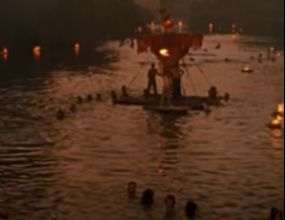
Iako se Romi često pojavljuju u filmovima, rijetko su u središtu priče. Značajna iznimka je djelo Emira Kusturice, jugoslavenskog i srpskog redatelja koji je skrenuo pozornost na romsku kulturu nagrađivanim filmovima. Kusturicin jedinstveni filmski stil, kombinirajući realizam s magijom, glazbom i tradicijom, upoznao je mnoge gledatelje s bogatstvom i složenošću romskog života.
Prijevod: Anna Krainova, Ema Bakunić
Romi su često predstavljeni u filmovima, ali u većini slučajeva samo kao sporedni likovi, i vrlo je malo redatelja izgradilo radnju zasnovanu na život Roma. Emir Kusturica, jugoslavenski i srpski redatelj, smatran se glavnim popularizatorom romske kulture u kinematografiji i može se reći da je on upoznao europsku publiku s romskim životom, a i su njegovi filmovi dobili prestižne nagrade. U svojim filmovima Kusturica kombinira realistične slike svakidašnjeg života, koje su ponekad drastične i brutalne s čarobnim elementima, masovno slavljenim praznicima, mnogo pjesama i tradicionalnom glazbom. Romski život također je prikazan u svim svojim oblicima i dobrim i lošim.
Prvi film koji treba spomenuti je ‘Dom za vješanje’ (1988.) koji pripovijeda povijest odrastanja mladog Roma po imenu Perhan s telekinetičkim moćima koji je bio uključen u kriminal i eksploataciju nakon što mu je bila obećana bolja budućnost u Italiji.
Važan detalj ovog filma je romski jezik na kojem je film bio snimljen, i to prvi put u svijetskoj kinematografiji. Iako je radnja filma očito smještna u Jugoslaviju, likovi ne govore srpski, hrvatski i druge jezike iz okruženja među sobom, što naglašava romski identicet i određenu izolaciju od društva i uranja publiku u svijet i kulturu Roma.
Film sadrži scene povijesno najvažnog praznika za Rome – Đurđevdana. Prvo prikazana scena je scena kućnog slavlja i zatim scena masovog slavlja na obali rijeke. Značajan dio ovog filma je tradicionalna romska pjesma "Đurđevdan/Ederlezi" koja se izvade za ovaj praznik u aranžmanu Gorana Bregovića. To je verzija koja je postala svjetski popularna i korištena u mnogim filmovima (naprimjer, u ’Turskom gambitu’ i ’Boratu’). Sama scena slavlja Đurđevdana na rijeci je stekla kultni status i postala referenca u brojnim filmovima i televizijskim serijama.
Praznici i narodni običaji općenito igraju važnu ulogu u radnji: gledajući film vidimo nekoliko vjenčanja, sahrana i prizore tradicionalnog čarobnog iscjeljenja u izvedbi Perhanove bake.
Muzika također nije samo značajan alat za pripovijedanje već i element svijetonazora likova. Bez obzira na poteškoće koje se događaju u životu, lakše ih je prebroditi s harmonikom u rukama, to je ono što je baka pripovijedala glavnom junaku. Takav romantičan svijetonazor je dopunjen svijetom živopisnih snova. Budući da je protagonis na rubu moralnog pada, shvaća da je gubitkom svojih snova zapravo izgubio i sebe, jer prema njegovim riječima Rom bez snove je kao crkva bez krova i nijemo zvono.
Drugi važan film koji portretira Roma, u karijeri Emira Kusturice, je komedija ‘Crna mačka, bijeli mačak’ (1998.). Ovaj film je kombinacija likova raznih dobi i nacionalnosti, priča, tradicija i jezika. Film ne samo da romantizira romski život predstavljajući ga kao beskrajan praznik, već se unatoč tome što je komedija, bavi važnim društvenim pitanjima Roma, poput dogovorenih brakova ili veza s podzemljem. Ipak, u kontekstu ovog filma svijet Roma je kao neki čarobni svijet gdje muzika liječi i ljudi žive u skladu s prirodom te ljubav pobjeđuje zlo. Ovo dijelo je puno humora i bezbrižnog stava prema životu, no Kusturica se ne smije Romima, već se smije s njima.
Međutim, ne može se zanemariti činjenica da su Kusturičani filmovi izazvali kontroverznu reakciju u romskoj zajednici. Neki ističu su istaknili da su filmovi puni stereotipa o Romima (krađa, prodaja dijece, prosjački život), drugi drže da je Kusturičin crni humor neprikladan za tu temu, a neki misle da je riječ o pretjerano generalizacije kulture i tradicije romskog društva također je izazvalo reakcije.
U suštini, koristeći apsurdnu kombinaciju slika surovog svakidašnjeg života i čarolije, kao i beskrajnih proslava s tradicionalnom muzikom, Emir Kusturica stvorio je u svojim filmovima "objektiv" za međunarodnu publiku koji omogućuje istraživanje romske kulture, no ne ocjenju svi ove filmove pozitivno. Oba filma, ‘Dom za vješanje’ i ‘Crna mačka, bijeli mačak’, koriste narative različitog stupnja ozbiljnosti kako bi naglasili i poteškoće i radosti života Roma.